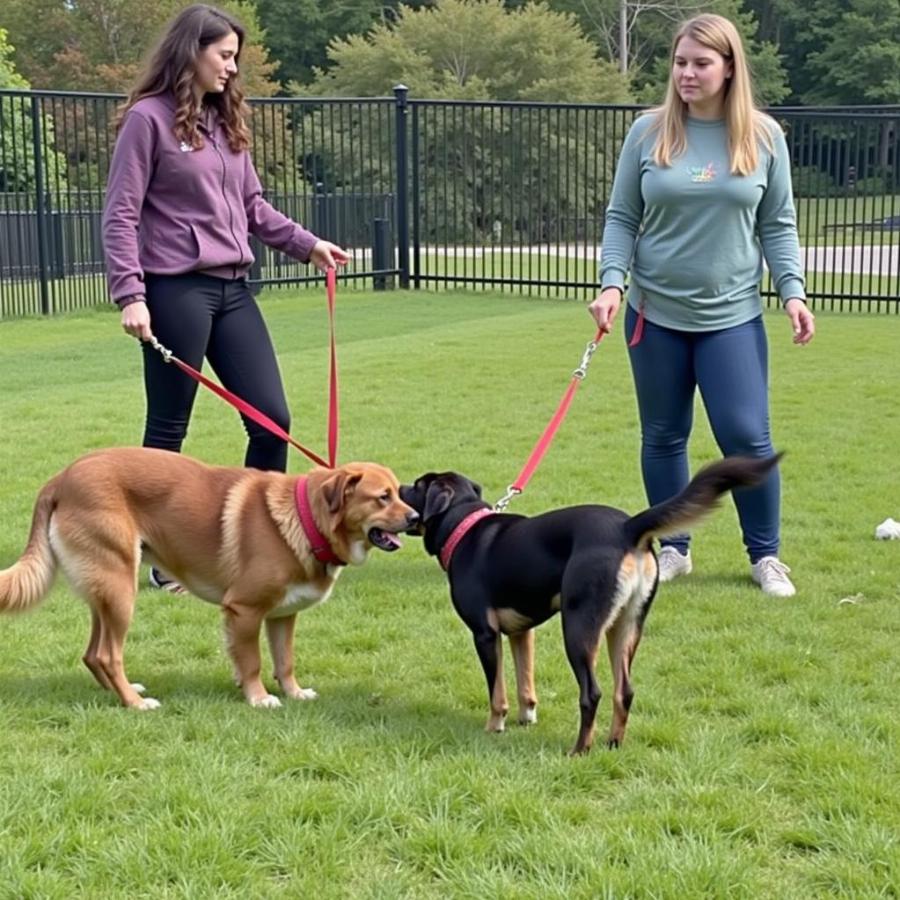Introducing two dogs can be a delicate process, but with patience and the right approach, it can lead to a beautiful, lasting friendship. A successful introduction relies on creating a positive and safe environment for both dogs. This comprehensive guide will cover everything you need to know about how to introduce two dogs, ensuring a smooth transition and minimizing potential conflict.
Preparing for the Introduction
Before the dogs even meet, laying the groundwork is crucial. This preparation helps reduce anxiety and sets the stage for a positive first impression.
Setting the Stage for Success
- Separate Spaces: Ensure each dog has their own designated space with food, water, toys, and a comfortable bed. This provides a safe retreat and minimizes resource guarding.
- Scent Swapping: Exchange bedding, toys, or even a worn t-shirt between the dogs. This allows them to become familiar with each other’s scent before a face-to-face meeting.
- Parallel Walks: Walk the dogs separately, but on the same path, maintaining a safe distance. This helps them acclimate to each other’s presence without direct interaction.
Initial Meeting: The First Impression
The first meeting should take place in a neutral, fenced area, preferably outdoors. Avoid confined spaces or areas either dog considers their territory.
- Leashed Introduction: Keep both dogs on loose leashes, allowing them to approach each other at their own pace. Avoid pulling or forcing interaction.
- Positive Reinforcement: Reward calm behavior with treats and praise. This helps create a positive association with the other dog.
- Supervise Closely: Watch for body language cues, such as wagging tails, relaxed posture, and play bows. Be prepared to intervene if any signs of aggression arise.
 First Meeting Between Dogs
First Meeting Between Dogs
Building the Bond: Gradual Integration
After a successful initial meeting, gradually increase the amount of time the dogs spend together.
Supervised Interactions
- Short, Frequent Sessions: Begin with short, supervised play sessions or walks, gradually increasing the duration as they become more comfortable.
- Neutral Territory: Continue using neutral territory for interactions until they consistently demonstrate positive behavior.
- Separate Feeding and Sleeping Areas: Maintain separate feeding and sleeping areas to prevent resource guarding and competition.
Common Challenges and Solutions
Introducing dogs can sometimes present challenges. Here are some common issues and how to address them:
Resource Guarding
- Separate Resources: Ensure each dog has their own food, water, toys, and resting areas.
- Trade-Up Games: Teach the dogs to exchange a lower-value item for a higher-value treat, creating a positive association with sharing.
Dominance Displays
- Neutralize Competition: Avoid situations that might trigger dominance displays, such as greeting visitors at the door or vying for attention.
- Obedience Training: Focus on obedience training for both dogs to establish clear boundaries and reinforce your role as the leader.
When to Seek Professional Help
If you encounter persistent aggression or are unsure how to handle specific situations, consult a certified professional dog trainer or behaviorist. They can provide personalized guidance and develop a tailored integration plan.
Conclusion
Introducing two dogs successfully takes time, patience, and a mindful approach. By following these steps and being attentive to your dogs’ individual needs, you can create a harmonious multi-dog household and foster a strong, loving bond between your furry companions. Remember, a slow and steady introduction is key to a long-lasting, positive relationship between your dogs. So take your time, be patient, and enjoy watching your furry family grow!
FAQs
- How long does it take for two dogs to get used to each other? It varies, but it can take anywhere from a few days to several months.
- What if my dogs fight during the introduction? Separate them immediately and consult a professional trainer.
- Can I introduce puppies and adult dogs the same way? The general principles are the same, but be extra cautious with puppies as they are more vulnerable.
- Should I let my dogs sleep together? Initially, it’s best to keep them separated at night until they are fully comfortable with each other.
- What if one of my dogs is significantly larger than the other? Supervise interactions closely to ensure the smaller dog feels safe.
More Helpful Resources on Beaut Dogs
- How Do You Walk Two Dogs at Once: Learn tips for managing two dogs on leash.
- Play with Dogs and Cats: Discover how to encourage positive interactions between dogs and cats.
Beaut Dogs: Your Ultimate Guide to Canine Companionship
Beaut Dogs is your one-stop resource for all things dog-related, providing expert advice, helpful tips, and in-depth information on breeds, care, and training. When you need expert advice, please contact us at [email protected] (Email address) for detailed and accurate answers. Visit https://beautdogs.com today to explore the wonderful world of dogs and learn how to care for them in the best way possible!